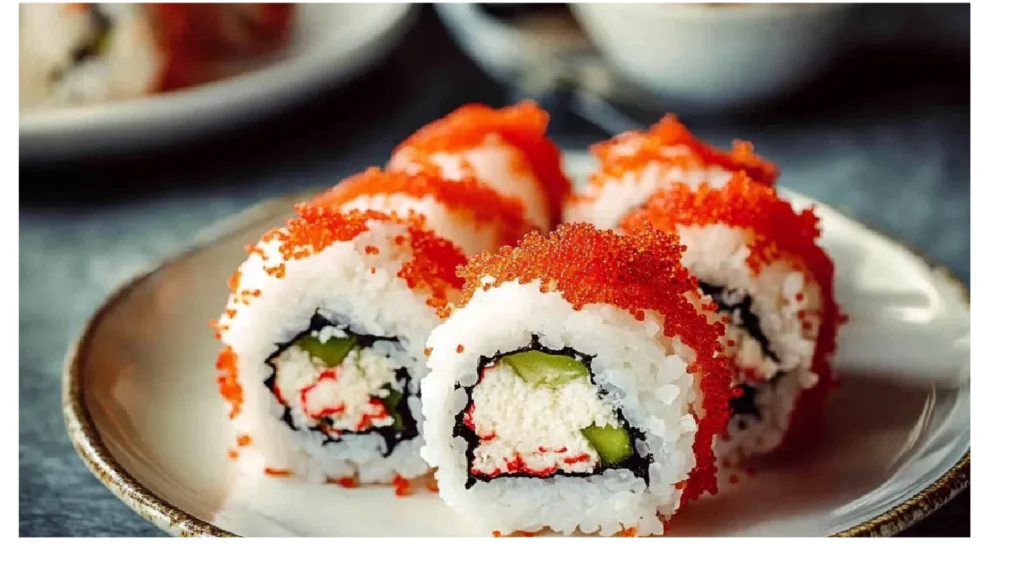Boston Roll Sushi is a mix of Japanese cuisine and Boston’s seafood. It has shrimp or crab, avocado, cucumber, and nori. It’s also topped with tobiko for a pop of color.
This roll is loved for its taste and look. It’s great for both sushi experts and beginners. It brings together fresh seafood, veggies, and Japanese flavors in a delicious way.
Introduction to Traditional Boston Roll Sushi
Boston roll sushi is a mix of Japanese cooking and East Coast tastes. It shows how sushi can change and grow, blending Japan’s traditions with New England’s flavors. The story of the Boston roll shows how different cuisines come together.
Origins and Cultural Significance
The Boston roll started in the city’s sushi scene. Chefs added cooked seafood and local favorites like cucumber and avocado. This made sushi more welcoming for newcomers.
This mix of flavors and methods shows the East Coast’s vibrant food world. Here, Japanese ways meet local tastes.
What Makes Boston Roll Unique
The Boston roll is special because it uses cooked seafood, like shrimp or crab. This makes it more welcoming for those who don’t like raw fish. The roll’s mix of savory seafood, cool cucumber, and creamy avocado is loved by many.
Popular Variations
- Philly Boston Roll: This version adds cream cheese for a richer taste.
- Spicy Boston Roll: Adding spicy mayo or sriracha gives it a kick.
- Vegetarian Boston Roll: It swaps seafood for avocado, cucumber, and veggies, making it a tasty meatless choice.

The Boston roll shows the creativity and flexibility of sushi. It’s a symbol of Japanese and American cooking coming together. This iconic roll is a favorite for both sushi fans and newbies.
Essential Ingredients for Perfect Boston Roll
Making a real Boston roll sushi needs careful picking of top-notch ingredients. The core of this tasty dish are the main parts that mix well together. They bring out a perfect balance of tastes and textures.
The base of the Boston roll is the sushi rice. It’s made with the right mix of rice, water, rice vinegar, sugar, and salt. Nori sheets, the seaweed wraps, give the roll its shape and unique taste. Cooked shrimp or crab add a nice texture, while avocado and cucumber bring a fresh crunch.
To make the Boston roll even better, a bit of spicy mayo or some tobiko or sesame seeds can be added. These ingredients work together to make a sushi that looks great and tastes amazing.
If you love sushi or are new to cooking, knowing the key ingredients of the Boston roll is a good start. With the best sushi ingredients, fresh seafood, sushi rice, and nori sheets, you can make a Boston roll that will please your taste buds.
“The Boston roll is a culinary masterpiece that showcases the perfect harmony of flavors and textures, making it a beloved choice among sushi enthusiasts.”
Step-by-Step Guide to Making Boston Roll Sushi
Making Boston roll sushi at home is all about mastering a few key steps. First, cook and season the sushi rice with the right vinegar ratio. Then, lay out a bamboo mat with plastic wrap and place a sheet of nori on it. Spread the seasoned sushi rice evenly, leaving a small border at the top.
Rice Preparation Techniques
To make the sushi rice, cook 2 cups of short-grain rice as the package says. After cooking, move the rice to a big bowl. Gently mix in 1/4 cup of sushi vinegar. Let the rice cool down, fluffing it with a fork to avoid sticking.
Filling Assembly Tips
- Line up your fillings, like cooked shrimp, ripe avocado, and cucumber sticks, in the middle of the rice.
- Then, sprinkle a lot of masago or tobiko (fish roe) over the fillings for that Boston roll taste and texture.
Rolling Methods and Tricks
With the bamboo mat, roll the nori-wrapped filling tightly. Make sure to apply even pressure. Moisten the nori’s edge with water to seal the roll. Use a sharp knife to cut the Boston roll into 6-8 pieces.
To make an inside-out Boston roll, put the rice on the outside and the nori on the inside. Remember, practice makes perfect in mastering sushi rolling techniques.
“The key to making delicious homemade sushi is paying attention to the details, from perfectly cooked rice to the precise rolling and cutting techniques.”
Selecting and Preparing Fresh Seafood
Making a great Boston Roll sushi begins with choosing top-notch, sushi-grade seafood. Cooked shrimp or imitation crab meat are key for this classic roll. Adding a tempura coating to shrimp can make it even crunchier.
It’s crucial to pick seafood that’s fresh and sushi-grade. This means the fish has been handled and chilled right. Always choose the best-looking seafood to ensure food safety.
- Opt for cooked shrimp or imitation crab meat for the Boston Roll filling
- If using shrimp, a tempura coating can add an enjoyable crunch
- Inspect seafood carefully, selecting only the freshest, sushi-grade options
After picking your protein, cook and cool it properly before making sushi. This step boosts flavor and keeps food safe. With the right seafood and prep, you’ll make a tasty Boston Roll.
The Art of Sushi Rice Making
To make the perfect Boston Roll sushi, you start with the rice. Japanese short-grain rice is best because it’s sticky and has the right texture. Rinse the rice until the water is clear to remove impurities.
Cook the rice as instructed, then season it with rice vinegar, sugar, and salt. This step is very important.
Perfect Rice-to-Vinegar Ratio
The right mix for sushi rice seasoning is 2 cups of cooked rice to 1/4 cup of vinegar mix. This mix of rice vinegar, sugar, and salt gives the rice a great taste. It’s tangy, sweet, and savory all at once.
When you mix the seasoning into the warm rice, make sure each grain is coated evenly. This is what makes the rice perfect for sushi.
Temperature Control Tips
- Let the cooked rice cool a bit before adding the seasoning. But don’t let it get too cold.
- Keeping the rice at the right temperature is key. You want it to stick together but not be mushy or dry.
- Work with the rice when it’s still a bit warm. This helps the seasoning mix in well and keeps the grains together but still delicate.
“The secret to exceptional sushi rice lies in the perfect balance of vinegar, sugar, and salt, combined with precise temperature control.”
Learning how to make sushi rice is the first step to making great Boston Roll sushi. It’s all about getting the flavors and texture just right.
Vegetable Preparation and Cutting Techniques
Making a delicious Boston Roll sushi needs careful veggie prep and cutting. The crunch and taste of julienned veggies like carrots and bell peppers make the roll pop. Also, slicing the cucumber and avocado thinly is key for the right texture and feel.
Start by slicing the cucumber lengthwise into thin strips with a sharp knife. This adds a nice crunch to the roll. For the avocado, slice it just before you put the sushi together to stop it from turning brown. Cut the avocado into thin slices, making sure they’re evenly spread in the roll.
- Julienne the cucumber, carrots, and bell peppers for added texture and flavor.
- Slice the avocado into thin, uniform pieces just before assembling the sushi.
- Cut all vegetables uniformly to ensure even distribution in the Boston Roll.
The freshness and crispness of the veggies are key for a balanced Boston Roll sushi. By carefully preparing and cutting the veggies, you can make this classic sushi dish even better.
Getting good at veggie prep for Boston Roll sushi is all about precision and detail. With a bit of practice, you’ll make rolls that show off the vibrant flavors and textures of the fresh produce.
Essential Tools and Equipment
To make tasty sushi at home, you need a few key tools. You’ll need a sushi rolling mat, a sharp sushi knife, and a rice cooker for sushi. These tools will help you make beautiful sushi rolls easily.
Must-Have Sushi Making Tools
- Bamboo sushi rolling mat (makisu): This flexible mat helps roll and shape the sushi. You can find a good quality bamboo mat for as little as $7 on Amazon.
- Sharp sushi knife: A thin, sharp knife is key for slicing sushi rolls perfectly. Look for a dedicated sushi knife or a high-quality chef’s knife.
- Rice cooker: An automatic rice cooker makes sushi rice easy to prepare. Choose a model that cooks about 1 cup of uncooked rice, enough for 6 sushi rolls.
- Mixing bowl: A large bowl is needed to mix the cooked sushi rice with rice vinegar, sugar, and salt for seasoning.
- Rice paddle: This flat wooden paddle helps mix and spread the sushi rice evenly.
Optional Accessories
While not essential, these accessories can make your sushi-making better and look nicer:
- Sushi knife (yanagiba): A dedicated sushi knife with a long, thin blade allows for precise, clean cuts through the sushi rolls.
- Plastic wrap: Lining the sushi mat with plastic wrap makes rolling the sushi easier and prevents sticking.
- Small dishes: Small dipping dishes for soy sauce, wasabi, and pickled ginger add a touch of authenticity to your sushi setup.
With these essential tools and a bit of practice, you’ll be well on your way to creating delicious, restaurant-quality sushi at home.
Sauce Combinations and Garnishes
Creating the perfect Boston Roll sushi is all about the sauce and garnish. Spicy mayo is a classic choice. It’s made by mixing mayonnaise with sriracha, adding a creamy, zesty flavor.
Looking for something different? Try eel sauce or ponzu. Eel sauce is sweet and savory, perfect with the Roll’s ingredients. Ponzu adds a tangy, refreshing taste.
Garnishes are key for looks and texture. Tobiko, or flying fish roe, adds crunch and ocean flavor. Sesame seeds, black and white, bring a nutty aroma and striking contrast.
Don’t be afraid to mix and match sauces and garnishes. You can create your own unique Boston Roll. It’s a great way to impress your guests with your creativity.
“The right sauce and garnish can truly make a Boston Roll sushi stand out.” – Sushi Chef Masayoshi Takayama
Ingredients
For the Sushi Rice:
2 cups cooked Japanese short-grain rice
1/4 cup rice vinegar
1 tablespoon sugar
1 teaspoon salt
For the Sushi Roll:
4 sheets nori (seaweed)
1/2 pound (225 grams) cooked shrimp or imitation crab meat
1 medium avocado, sliced thin
1 medium cucumber, julienned
3 tablespoons spicy mayo (mix mayonnaise with sriracha)
Optional Garnishes:
2 tablespoons tobiko (flying fish roe) or masago (capelin roe)
1 tablespoon black or white sesame seeds
Dipping Sauces and Sides:
Soy sauce, as needed
Wasabi, for serving
Pickled ginger, for serving
Execution
Prepare the Sushi Rice
The foundation of Boston Roll Sushi lies in perfectly seasoned sushi rice. Start by rinsing 1 cup of Japanese short-grain rice under cold water until the water runs clear. Cook the rice in a rice cooker or stovetop according to package instructions. Once cooked, transfer it to a large bowl. In a separate saucepan, gently heat 1/4 cup rice vinegar, 1 tablespoon sugar, and 1 teaspoon salt until the sugar and salt dissolve. Pour this mixture over the warm rice and mix gently to coat every grain. Allow the rice to cool to room temperature before use.
Prepare the Fillings
The fillings are what give Boston Roll Sushi its signature flavor and texture. Peel and slice 1 medium avocado into thin, even pieces. Julienne 1 medium cucumber into thin strips for crunch. If using cooked shrimp, slice them in half lengthwise. For imitation crab meat, gently shred it by hand. Having your fillings prepped and ready makes assembling the sushi much easier.
Set Up Your Sushi Station
A clean and organized station is essential for a smooth sushi-making process. Place a bamboo sushi mat on a flat surface and cover it with plastic wrap to prevent sticking. Lay a sheet of nori, shiny side down, on the mat. This setup ensures a tidy workspace and makes rolling easier.
Spread the Sushi Rice
Spreading the rice evenly ensures a balanced and well-rolled sushi. Wet your hands with water to prevent the rice from sticking, then spread a thin layer of sushi rice over the nori, leaving a 1-inch border at the top. The rice should be evenly distributed for a seamless roll.
Add the Fillings
Layering the fillings is the heart of creating a Boston Roll. Place cucumber sticks and avocado slices horizontally across the middle of the rice. Top with shrimp or imitation crab meat. For an extra touch, sprinkle tobiko or sesame seeds to enhance the texture and flavor.
Roll the Sushi
Rolling tightly is crucial for a neat and compact Boston Roll. Lift the bamboo mat’s edge closest to you and start rolling while keeping the fillings in place. Apply light pressure as you go to maintain a firm shape. Seal the roll by moistening the nori’s exposed edge with water.
Slice the Sushi Roll
Slicing cleanly ensures that each piece of Boston Roll looks professional. Use a sharp knife dipped in water to cut the roll into 6-8 equal pieces. Wiping the blade after each cut helps maintain precision and prevents sticking.
Garnish and Serve
Enhance the presentation of your Boston Roll Sushi with garnishes and sauces. Arrange the pieces neatly on a serving plate and top with tobiko or sesame seeds for visual appeal. Serve with soy sauce, wasabi, and pickled ginger on the side. Enjoy your homemade Boston Roll Sushi!
Additional tips
- Use fresh ingredients: Always choose sushi-grade seafood and fresh vegetables for the best taste and safety.
- Chill your fillings: Keep shrimp, avocado, and cucumber refrigerated until ready to use for easier handling.
- Dampen your knife: Dip your knife in water between cuts to slice the sushi roll cleanly without sticking.
- Experiment with sauces: Try eel sauce or ponzu for a unique twist on classic Boston Roll flavors.
- Customize the fillings: Add julienned carrots, bell peppers, or cream cheese for a personal touch.
- Practice rolling techniques: Don’t worry if the first roll isn’t perfect—each attempt improves your skills.
- Serve immediately: Sushi tastes best when freshly prepared, so enjoy it right after assembly.
Common Mistakes to Avoid
Making the perfect Boston roll sushi needs focus and a few important techniques. Stay away from common mistakes that can ruin your sushi-making. Keep these tips in mind to avoid them.
Overfilling the Roll
One big mistake is putting too much filling in the roll. This can make the roll burst or become too big. It’s hard to slice and serve neatly. Use just the right amount of fillings for a balanced, tight roll.
Uneven Rice Distribution
It’s key to spread the sushi rice evenly on the nori (seaweed sheet). Uneven rice can make the roll lopsided or hard to roll. Make sure to spread the rice thinly and evenly before adding fillings.
Using Warm Rice
Warm sushi rice can make the nori soggy and hard to roll. Let the rice cool a bit before making your Boston roll. This keeps the seaweed crisp and the roll’s texture right.
Selecting Subpar Ingredients
The quality of your ingredients is crucial in sushi. Don’t use old or wilted veggies, as they can ruin the freshness and texture. Also, be careful not to add too much wasabi or soy sauce. They can overpower the sushi’s delicate flavors.
Avoiding these common mistakes will help you make delicious Boston roll sushi. It will highlight the freshness of the seafood and the crunch of the cucumber.
“The secret to making great sushi is all in the rice. If the rice is not perfect, the whole dish will be off.” – Jiro Ono, renowned sushi chef
Serving and Presentation Tips
Make your Boston Roll Sushi stand out by focusing on plating and presentation. Place the sliced rolls neatly on a clean, attractive plate. You can arrange them in a row or a fan shape.
Add extra avocado slices, thin cucumber strips, or a sprinkle of tobiko (flying roe) for color and interest. This will make your dish look appealing.
For a sushi making party, create a DIY station with different ingredients. Let your guests make their own rolls. Offer small dishes with soy sauce, wasabi, and pickled ginger for them to customize their sushi.
Good presentation makes the dish look better and makes eating it more enjoyable. By focusing on looks and letting guests create their own, you show off the beauty and versatility of Boston Roll Sushi.




